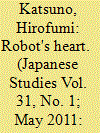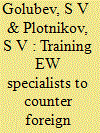|
|
|
Sort Order |
|
|
|
Items / Page
|
|
|
|
|
|
|
| Srl | Item |
| 1 |
ID:
097295


|
|
|
| 2 |
ID:
051918


|
|
|
| 3 |
ID:
130438


|
|
|
| 4 |
ID:
104169


|
|
|
|
|
| Publication |
2011.
|
| Summary/Abstract |
This paper explores the processes by which humanoid robots become sites of affective investment in contemporary Japan. It particularly analyses how narratives of intimacy, conventionally found in relationships between humans, are being reproduced and embodied in interactions with humanoid robots. It uses ethnographic research on participants in Robo-One, one of Japan's most popular robotics events, to examine the development of intimate relationships between the human and the robotic, understood in terms of kokoro (loosely translated as 'heart'). The robot's heart emerges in the grey area between technological material and human imagination. Through the respective processes of tinkering and spectating, both robot builders and 'robot watchers' experience the intimacy that results from apprehending the robot's heart. This experience creates an endless hermeneutic circle, drawing together subject and object, original and copy, creator and created, and watcher and watched, to ultimately reconfigure participants' senses of their own kokoro.
|
|
|
|
|
|
|
|
|
|
|
|
|
|
|
|
| 5 |
ID:
079224


|
|
|
| 6 |
ID:
156141


|
|
|
|
|
| Summary/Abstract |
The authors give reasons for the compulsory training of EW specialists for struggle against foreign armies' control systems of unmanned aerial vehicles and robots in military institutions of higher learning.
|
|
|
|
|
|
|
|
|
|
|
|
|
|
|
|
| 7 |
ID:
170768


|
|
|
|
|
| Summary/Abstract |
The paper starts with a section which briefly outlines the operating environment the Army is likely to operate in, emphasising the aspects of enhanced mobility, lethality and small enemy fighting groups of a nation state or trans-border terrorists or hybrid of the two.
In the next section, there is a brief expose on the evolution of network centricity and a listing of the military relevant new age technologies that are emerging.
The paper goes on to examine the objective and capability enhancements that will be required to thwart the enemy designs on the battlefield, counter use of emerging technologies, present adversaries with multiple dilemmas and beat the enemy. The five capability enhancement areas are – situational awareness, physical and cognitive load, sustainability, mobility and manoeuvre, protection of the force and common control.
The next section identifies relevant segments of technology, formed by combination of earlier listed technologies, to achieve the identified enhancements required. These segments are – Artificial Intelligence, Autonomous Robotics, common controls and secure data communications. The need for evolving a simultaneous conceptual framework is also covered briefly.
The paper lays down short, medium and long term time lines and spells out some of the recommended activities in each phase. A cycle of ideate, research, test, accept / reject, centre of excellence (CoE), productise is introduced that obliquely refers to make in India. Importance of innovation and creative thinking leading to productisation is emphasised.
In the last section, an attempt is made to identify major stake holders from army, academia and industry to take the concept forward in a collaborative, inclusive and adaptive manner by instituting regulation, control and execution layers. A recommendation to set up multi domain joint interest groups under this mandate is made.
|
|
|
|
|
|
|
|
|
|
|
|
|
|
|
|
|
|
|
|
|